Male and females alike desire a strong, nice-looking backside. And there are added benefits as well—the glutes are the body’s posterior powerhouse, affecting everything from walking and jumping to sitting and standing. When we talk about training the glutes, it’s important to consider how we move in life and in sport. We want to improve our function in movement through all planes of motion and angles. Our glutes do more than extend the hips in the saggital plane, yet we seem to get stuck in performing saggital plane movements, such as a walking lunge or squat.
We also tend to focus too much on the concentric contraction of the work and allow gravity or mindlessness to do our work in the eccentric work phase. For this reason, most injuries occur during the eccentric phase of contraction. To counteract this tendency, we should focus more on the eccentric phase during many lower-body exercises.
The following drills are designed to build power and strength and increase mobility, challenging some of the many ways we move. Perform each exercise for 30-40 seconds.
DVRT Shucking
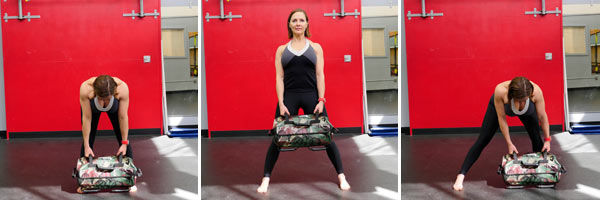
Position your feet slightly wider than hip-distance apart and perform a deadlift using a Power Ultimate Sandbag (USB). Maintain a plank position and keep your shoulders set as you hinge from the hips laterally, moving to one side with the USB hanging directly down from the shoulders; arms should be shoulder-width apart. Ideally, the USB should be over the top of the middle of your foot. The greater your hip mobility, the closer to the floor the USB will be. Drive through the foot to move the body to the other side without lifting up in the center. Make sure your hips are parallel to the floor. This exercise can help expose hip imbalances.
DVRT FL Crossing Rear Leg Dead Lift
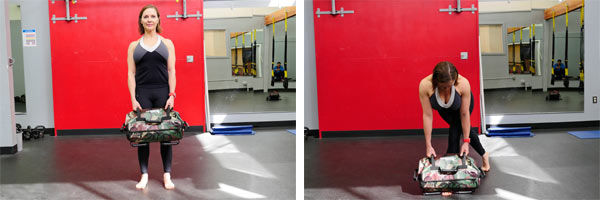
Position your feet in a bilateral stance and perform a deadlift using a USB. Pack your shoulders and step slowly back and at an angle, crossing the midline. Shorten your stance if you cannot maintain a stable position. Slowly hinge at your hips, keeping the USB close to your leg. Focus on the eccentric part of the movement and be mindful not to round your back or shoulders. Drive off of the front heel, maintaining contact with the rear ball of the foot, and powerfully drive the body back to a standing position.
Hip/Back Extensions
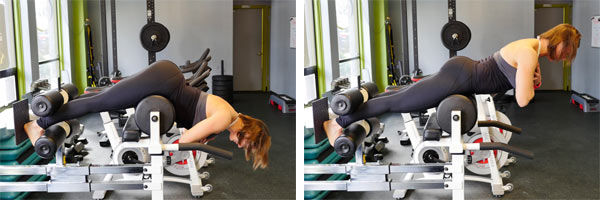
Position yourself on a glute/ham machine so that the pad is right below the hips. Press your feet strongly into the footplate and slowly lower your torso toward the ground. Pay close attention to the eccentric contraction. Squeeze your glutes together while pressing the feet into the footplate and raise to a full extension; avoid hyperextending the back. Hold for a beat and then slowly lower again. Make sure your back can stay in a plank position throughout the full movement; don’t allow any rounding of the low back.
TRX Lunge With Hip Hinge
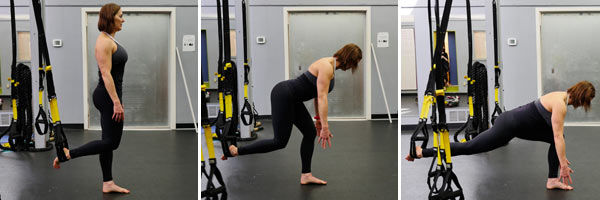
Adjust the TRX Suspension Trainer to mid-calf and stand facing away with one foot in the foot cradles, toes pressing toward the floor. Keep the torso strongly engaged and begin to lower the body, allowing the hip hinge to drive the movement down and back. As you lower toward the floor, the leg in the foot cradle will follow the lead of the hip hinge and begin to extend behind you. Your degree of hip mobility will determine the depth of your hinge. Don’t allow your back to round.
McGill Airplane
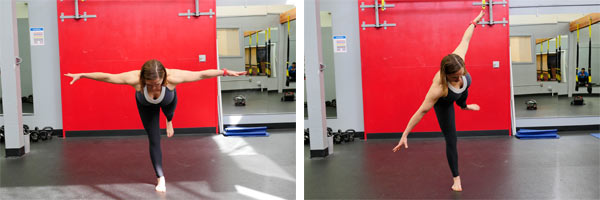
Stand on one leg with hips parallel to the floor; lock the rib cage onto the pelvis to create a brace in your core. Keep the pelvis on the supporting leg flexed and begin to externally rotate the extended leg, directing the hip up. Internally rotate the hip back to the starting position. This drill works the gluteus maximus through its full range of motion, under load and with control; balance is challenged as well.




 by
by 









 by
by